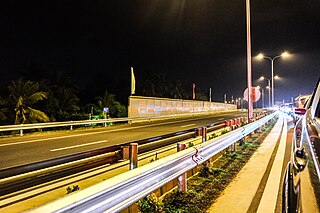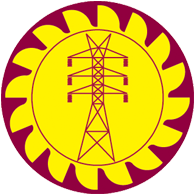
Transport in Sri Lanka is based on its road network, which is centred on the country's commercial capital Colombo. A rail network handles a portion of Sri Lanka's transport needs. There are navigable waterways, harbours and three international airports: in Katunayake, 35 kilometres (22 mi) north of Colombo, in Hambantota, and in Jaffna.

Hambantota is the main town in Hambantota District, Southern Province, Sri Lanka. This underdeveloped area was hit hard by the 2004 Indian Ocean tsunami and is undergoing a number of major development projects including the construction of a new sea port and international airport finished in 2013. These projects and others such as Hambantota Cricket Stadium are said to form part of the government's plan to transform Hambantota into the second major urban hub of Sri Lanka, away from Colombo.

The Ceylon Electricity Board - CEB, is the largest electricity company in Sri Lanka. With a market share of nearly 100%, it controls all major functions of electricity generation, transmission, distribution and retailing in Sri Lanka. It is one of the only two on-grid electricity companies in the country; the other being Lanka Electricity Company (LECO). The company earned approximately Rs 204.7 billion in 2014, with a total of nearly 5.42 million consumer accounts. It is a government owned and controlled utility of Sri Lanka that takes care of the general energy facilities of the island. The Ministry of Power and Energy is the responsible ministry above the CEB. Ceylon Electricity Board (CEB), established by an CEB Act No. 17 of 1969, is under legal obligation to develop and maintain an efficient, coordinated and economical system of Electricity supply in accordance with any Licenses issue

The Lakvijaya Power Station is the largest power station in Sri Lanka.

People's Bank is a state-owned commercial bank in Sri Lanka. Second largest commercial bank in Sri Lanka. Established on 1 July 1961, it has its head-offices at Sir Chittampalam A. Gardiner Street in Colombo. The bank offer both retail and corporate banking services, with a network of 739 local branches, service centers and has an asset base of LKR 1.873 trillion (2019) with over 14 million customers. People's Bank received a high national long-Term Rating of AA+ by Fitch Rating. People's bank most awarded state-owned company such as "Green Plus" "Carbon Conscious Award". People's Bank became Sri Lanka's best performing bank. Bank mainly target small and medium enterprise.

The electricity sector in Sri Lanka has a national grid which is primarily powered by hydro power and thermal heat, with sources such as photovoltaics and wind power in early stages of deployment. Although potential sites are being identified, other power sources such as geothermal, nuclear, solar thermal and wave power are not used in the power generation process for the national grid.
The Hambantota Solar Power Station is the first commercial-scale solar power station in Sri Lanka. The photovoltaic solar facility was constructed in Buruthakanda, in the Hambantota District. The plant is owned and operated by the Sri Lanka Sustainable Energy Authority, a state-run organization responsible for renewable resources.

China–Sri Lanka relations are the bilateral relations between the People's Republic of China and Democratic Socialist Republic of Sri Lanka. There is a Chinese embassy located in Colombo and a Sri Lankan embassy situated in Beijing. Historical and cultural ties between the two countries extend back hundreds of years.
The Rajapaksa family is a Sri Lankan family that is prominent in politics. It was one of Sri Lanka's most powerful families during Mahinda Rajapaksa's Presidency, where many members of the family occupied their senior positions in the Sri Lankan state. As their political power grew, there were reports suggesting that the country was heading towards autocracy under their rule. Following the unexpected defeat of Mahinda Rajapaksa in the 2015 Presidential Election, they have been accused of authoritarianism, corruption, nepotism and bad governance. In 2019 Presidential election Gotabaya Rajapaksa, brother of Mahinda Rajapaksa contested and won.
The Kelanitissa Power Station is a state-owned power station located on the south bank of the Kelani River in the northern part of the city of Colombo, Sri Lanka. Commissioned in 1964, it is the first thermal power station built in Sri Lanka, after the country gained independence. The facility has a current gross installed capacity of 360 MW, a significant amount when compared to the total installed capacity of nearly 4,086 MW in the year 2017. The facility is owned and operated by the Ceylon Electricity Board.

The Mampuri Wind Farms are a set of three wind farms located near the Lakvijaya Power Station, on the Kalpitiya peninsula, in Mampuri, Puttalam District, Sri Lanka. The wind farms, referred to as Mampuri-I, Mampuri-II, and Mampuri-III, was built successively, and consists of eighteen Suzlon wind turbines ranging from 1.25 MW to 2.10 MW. Mampuri-I was commissioned on 22 March 2010, and was the first wind farm in the country to reach the 10 MW installed capacity threshold. As the government only allows projects up to 10 MW, the three wind farms are registered under three different company names, namely Senok Wind Power, Senok Wind Energy, and Senok Wind Resource.

The Uppudaluwa Wind Farm is a 10.5 MW wind farm owned by PowerGen Lanka (Private) Limited in Uppudaluwa, Puttalam, Sri Lanka.
The Nirmalapura Wind Farm is a 10 MW wind farm consisting of seven wind turbines, located on the west coast of Nirmalapura, Puttalam, Sri Lanka. The plant is owned by Nirmalapura Wind Power (Private) Limited, and was commissioned in September 2011.

The Nilambe Dam is a small hydroelectric dam build across the Nilambe River, measuring approximately 70 m (230 ft) in length. Water from the Nilambe Dam is transferred to the 3.2-megawatt Nilambe Power Station through a penstock measuring approximately 2.8 km (1.7 mi). The power station consists of two 1.6 MW generating units, which were commissioned in July 1988.
Chunnakam Power Station was a thermal power station in Chunnakam in northern Sri Lanka. Commissioned in 1958, the station is owned and operated by the state-owned Ceylon Electricity Board (CEB). It was decommissioned in 2013, and replaced by the Uthuru Janani Power Station, which is constructed less than 100m south of the Chunnakam Power Station.

The Thambapavani Wind Farm named after Thambapanni and Pavan meaning wing in Sinhalese. Also called Mannar Island Wind Farm or Mannar Wind Farm) is a 100-megawatt wind farm which was built on the southern coast of the Mannar Island, in Sri Lanka. The project would cost approximately US$200 million, 78% of which will be borne by the Asian Development Bank, while the remaining 22% will be borne by the developers, the Ceylon Electricity Board. Identification of land plots and ownership has already begun. It is currently regarded as the largest wind farm in Sri Lanka and it is also the first wind power plant to be owned by the Ceylon Electricity Board.
The KCHT Power Station is a municipal solid waste-fired thermal power station currently under construction at Muthurajawela in Sri Lanka. It is being constructed together with the Aitken Spence Power Station, after it won the bid by the Urban Development Authority from a pool of 121 bidders, 19 of which were foreign. Construction of the facility began on 10 August 2017 and will cost approximately US$95 million, with an estimated completion slated for mid-2019.
The Sagasolar Power Station is a solar photovoltaic power station built next to the Hambantota Solar Power Station, in Hambantota, Sri Lanka. The solar farm is owned and developed by Sagasolar, a joint venture between LOLC Group and Faber Capital Limited, with 70% debt funded by DFCC Bank, Commercial Bank of Ceylon, and Hatton National Bank. The 10-megawatt facility is expected to generate approximately 19GWh annually for at least 25 years.

The Sapugaskanda Refinery is the single largest oil refinery of Sri Lanka. The refinery was built by Iran under the guidance of the Ceylon Petroleum Corporation in August 1969, initially designed to process 38,000 barrels (6,000 m3) per stream day of Iranian Upper Zakum crude oil, and Arabian light crude oil. It was commissioned on 12 October 1969. The facility, which covers an area of 165 acres (67 ha), currently has a capacity of 50,000 barrels (7,900 m3) per stream day.














